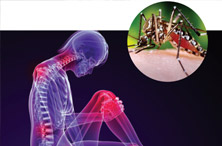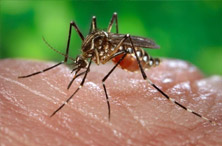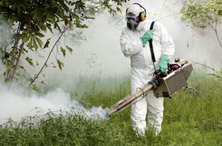Chikungunya
 Dr Ahmed Al-Mandhari, WHO Regional Director for the Eastern Mediterranean, visits a health center in Kassala, Sudan, to see patients treated for Chikungunya. (Photo: WHO)
Dr Ahmed Al-Mandhari, WHO Regional Director for the Eastern Mediterranean, visits a health center in Kassala, Sudan, to see patients treated for Chikungunya. (Photo: WHO)
Chikungunya is a viral disease transmitted to humans by Aedes mosquitoes. It causes fever and severe joint pain, which is often debilitating and may persist for several months, or even years. Other symptoms include muscle pain, headache, nausea, fatigue and rash. Joint pain is often debilitating and can vary in duration. The disease shares some clinical signs with dengue fever and zika virus infection, and can be misdiagnosed in areas where these are common.
Although the disease, which was first described during a 1952 outbreak in southern Tanzania, mostly occurs in Africa, Asia and the Indian subcontinent, a major outbreak in 2015 affected several countries in the Americas. In the Eastern Mediterranean Region, chikungunya was first found during serological surveys conducted in Pakistan in 1983. In 2011, Yemen reported the first outbreak in the Region resulting in over 15000 suspected cases and 104 suspected deaths. In 2017, Pakistan reported a major outbreak with over 8000 cases affecting multiple provinces. Sporadic cases of chikungunya have been reported also from Saudi Arabia and Sudan. In 2018, Sudan also reported an outbreak of chikungunya in its eastern states.
There is currently no cure for chikungunya and treatment is focused on symptom relief.
Since the proximity of mosquito breeding sites to human habitation is a significant risk factor for chikungunya, prevention and control relies heavily on reducing the number of natural and artificial water-filled container habitats that support breeding of the mosquitoes. People travelling to risk areas should make use of repellents, wear long sleeves and pants, and ensure rooms are fitted with screens to prevent mosquitoes from entering. During outbreaks, insecticides may be sprayed to kill flying mosquitoes, applied to surfaces in and around containers where the mosquitoes land, and used to treat water in containers to kill the immature larvae.
WHO helps countries to respond to chikungunya with outbreak management plans, technical support and training, direct and published guidance, and improvement of reporting systems.
Information resources

Tool for the diagnosis and care of patients with suspected arboviral diseases
Guidelines for prevention and control of chikungunya fever
Guidelines on Clinical Management of Chikungunya Fever
Protecting the health and safety of workers in emergency vector control of Aedes mosquitoes
Monitoring and managing insecticide resistance in Aedes mosquito populations




